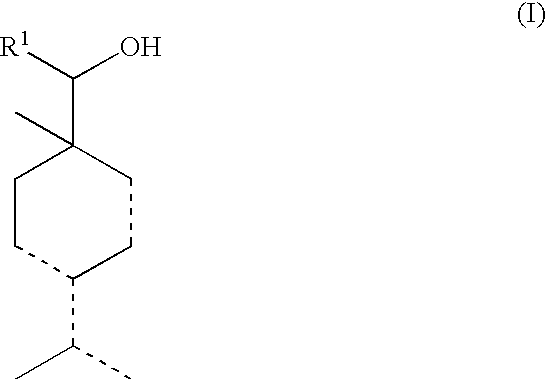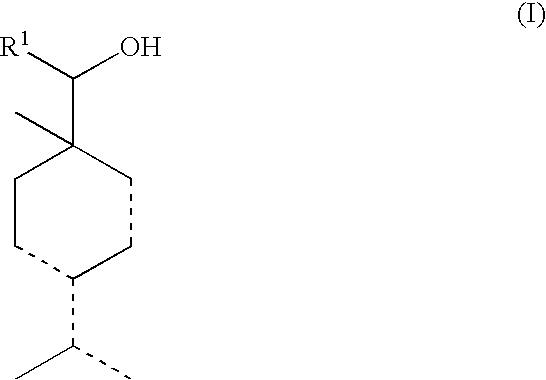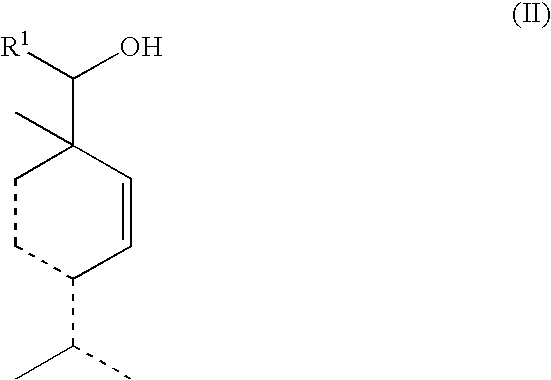Alcohol compounds
a technology of alcohol compounds and compounds, applied in the field of alcohol compounds, to achieve the effect of excellent persistence of fragrance and low cos
- Summary
- Abstract
- Description
- Claims
- Application Information
AI Technical Summary
Benefits of technology
Problems solved by technology
Method used
Image
Examples
example 1
Synthesis of 4-isopropyl-1-methylcyclohexa-2,4-dienylmethanol and 4-isopropylidene-1-methyl-2-cyclohexenylmethanol
[0056]A flask was charged with 53 g of paraformaldehyde, 160 g of 1-isopropyl-4-methyl-1,3-cyclohexadiene and 269 g of glacial acetic acid, and the contents of the flask were reacted with each other at 100° C. for 25 h. The resulting reaction mixture was cooled to room temperature, and then after adding 200 mL of an ether thereto, the obtained mixture was washed with a saturated sodium chloride solution and concentrated to obtain 257 g of a reaction solution. To 250 g of the thus obtained reaction solution were added 250 g of water and 100 g of a 48% sodium hydroxide solution, and the obtained mixture was reacted at 95° C. for 5 h, followed by cooling the reaction mixture to room temperature. The reaction mixture was extracted with 75 mL of an ether three times, and the extract solution was washed with a saturated sodium chloride solution. Thereafter, the resulting solut...
example 2
Synthesis of 4-isopropyl-1-methyl-3-cyclohexenylmethanol from 4-isopropyl-1-methylcyclohexa-2,4-dienylmethanol
[0065]A glass reaction vessel was charged with 5 g of 4-isopropyl-1-methylcyclohexa-2,4-dienylmethanol produced by the same method as used in Example 1, 0.1 g of 5% Pt / C (water content: 55%) and 50 mL of isopropanol, and the contents of the reaction vessel were reacted with each other at a pressure of from 0.1 to 0.3 MPa and a temperature of 30° C. for 2 h. Thereafter, at the time at which the amount of hydrogen consumed reached 0.55 mole per 1 mole of the raw material, the reaction was stopped, and the reaction mixture was filtered to remove the catalyst therefrom, and then concentrated to obtain 5 g of a reaction solution. The resulting reaction solution was purified using a silica gel column (eluant: hexane / ethyl acetate), and then distilled to obtain 1 g of 4-isopropyl-1-methyl-3-cyclohexenylmethanol.
[0066]The thus obtained 4-isopropyl-1-methyl-3-cyclohexenylmethanol had...
example 3
Synthesis of 4-isopropyl-1-methyl-3-cyclohexenylmethanol from 4-isopropylidene-1-methyl-2-cyclohexenylmethanol
[0070]A glass reaction vessel was charged with 10 g of 4-isopropylidene-1-methyl-2-cyclohexenylmethanol produced by the same method as used in Example 1, 0.05 g of 5% Pd / C (water content: 53%) and 20 mL of isopropanol, and the contents of the reaction vessel were reacted with each other at a pressure of from 0.1 to 0.4 MPa and a temperature of 30° C. for 4.5 h. Thereafter, at the time at which the amount of hydrogen consumed reached 1.2 moles per 1 mole of the raw material, the reaction was stopped, and the reaction mixture was filtered to remove the catalyst therefrom, and then concentrated to obtain 4-isopropyl-1-methyl-3-cyclohexenylmethanol with a yield of 73%.
PUM
| Property | Measurement | Unit |
|---|---|---|
| temperature | aaaaa | aaaaa |
| temperature | aaaaa | aaaaa |
| pressure | aaaaa | aaaaa |
Abstract
Description
Claims
Application Information
 Login to View More
Login to View More - R&D
- Intellectual Property
- Life Sciences
- Materials
- Tech Scout
- Unparalleled Data Quality
- Higher Quality Content
- 60% Fewer Hallucinations
Browse by: Latest US Patents, China's latest patents, Technical Efficacy Thesaurus, Application Domain, Technology Topic, Popular Technical Reports.
© 2025 PatSnap. All rights reserved.Legal|Privacy policy|Modern Slavery Act Transparency Statement|Sitemap|About US| Contact US: help@patsnap.com



